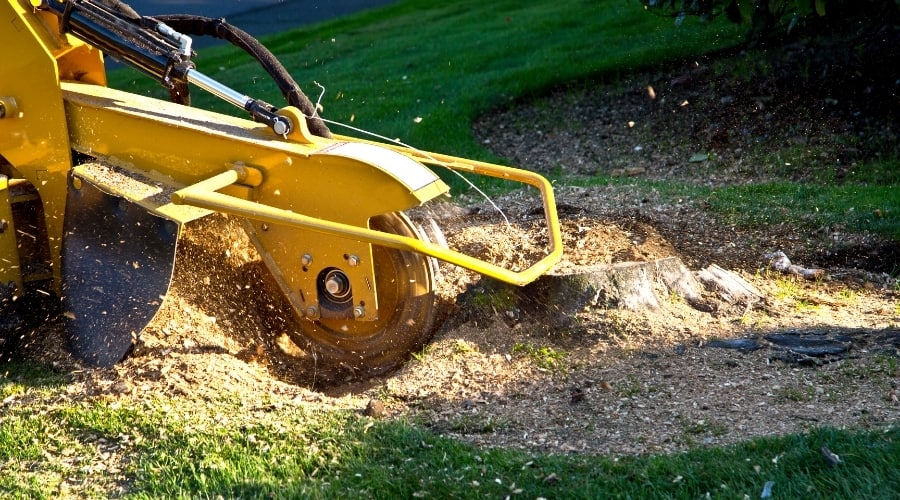Oak roots can stretch for hundreds of miles. As trees age, they continue to extend their subterranean network slowly. Naturally, that continued growth is part of why trees can weather storms and live for centuries.
The stump is still getting energy from the root network when you cut a tree down, but what happens to roots after stump grinding? Are the roots alive?
Table of Contents
What Happens To Roots After Stump Grinding
A tree’s roots will naturally decay over time after stump grinding. It can take up to 10 years for the roots to die when cut off from its food source. Stump grinding doesn’t remove the roots; however, the roots will die due to the lack of nutrients it received from photosynthesis that the tree provided.
Do Tree Roots Die After Stump Grinding
Tree roots will die after stump grinding. Just as the roots carry nutrients and water up to the tree, they get nutrition in return.
All the green leaves on a tree are filled with photosynthetic cells. The green color of chlorophyll is a natural byproduct of trees turning nutrients, water, and sunlight into usable, edible sugars.
The entire tree, not just the trunk and leaves but also the root system, needs the sugars to survive. Cell growth within the tree is a cooperative process between the lowest parts and the highest.
The trunk in the middle connects the two, so they can make the necessary exchange.
A tree trunk contains sap. While it’s not as complex as a human vascular system and flows more slowly, the sweet liquid works like our blood.
Sugars from the leaves travel down to feed the body and roots. Plus, when the tree is damaged, the sap seals off the wound and coagulates.
How Long Does It Take For Roots To Die After Stump Grinding
It can take up to ten years for roots to die when cut off from food sources. However, if you left it alone, the stump would last significantly longer.
Tree roots can be as thick around as a smaller tree’s trunk, but they will never be larger in diameter than the plant they are attached to.
The ability to spread out, both underground and above, is a tree’s way of reaching more food. A single root wouldn’t be able to touch very many nutrients in the soil.
The absorption process would be slower, and eventually, there would be none left. By thinning out and reaching further, the tree continues to get what it requires.
A small, stubby tree often has obstructions like rocks in the way of its root expansion.
Does Stump Grinding Remove Roots
Stump grinding doesn’t remove the tree’s roots. A few pieces near the stump may get caught up, but the majority will still be spread out below the soil’s surface.
Grinding is more cosmetic and functional for fields or homes that need smooth, even ground for building or planting.
Some trees have shallow roots. Beech, cottonwood, spruce, and maples often have more roots near the surface. These will be among the easiest to remove thoroughly.
Moreover, shallow-rooted trees leave shallower depressions in the dirt as they rot.
Alternately, according to Rutgers, Shepherd’s tree or Boscia Albitrunca has the deepest roots averaging around two-hundred and thirty feet deep.
Because these grow in the Kalahari Desert, they must reach the water table deep under the surface. Fortunately, you won’t need to worry about removing Shepherds’ tree roots in the US.
Will Roots Grow After Stump Removed
A trees’ roots stop growing once the tree is cut. Even before the stump is gone, the roots and stump have begun the excruciatingly slow process of death and decay.
Because trees are made of dense wood, it takes the decomposers in nature a long time to break it back down into nutrients for the soil.
Some tree roots are capable of putting off sprouts. These sprouts, known as suckers, are the trees bid for life. If suckers can establish themselves, like branches, they will leaf out and provide the roots with more sugars to survive.
How Do You Get Rid Of Roots After Stump Grinding
The easiest way to get rid of shallow tree rots after stump grinding is to wait them out and allow them to decompose naturally. Although this can take years, it is the least labor-intensive option. Quite literally, you do nothing.
A faster option is to use the same stump grinder to chip the roots up. While this will only take a day or two, it is also more hit and miss. Tree roots are unpredictable and plentiful.
For complete removal, you or a tree removal service will need to dig out the roots. This process is tedious and labor-intensive.
Deciding which method works for you depends on the type of tree and how deep you need the soil to be empty of obstructions.
What To Do After Stump Grinding To Stop Roots From Growing Back
There are two straightforward ways to prevent roots from regrowing after using a stump grinder. You can either dig the roots out and remove them entirely or watch out for suckers.
Newer, more petite suckers are easy to trim or mow. As Gardeningknowhow points out, suckers are baby trees that sprout from the roots without a new seed.
Unfortunately, if you leave them for too long, suckers will thrive, grow and feed the roots. In an extreme case, you could end up with several smaller trees, but they wouldn’t last.
One of the sucker trees would outcompete its fellows, and the root would spread again.
Helpful Tips To Know About What Happens To Roots After Stump Grinding
Regrettably, there are very few options for tree root removal. Whether you pull them out or let them decompose, eventually, they will return to the earth as nutrients.
Here are some helpful tips to know about what happens to roots after stump grinding.
- If you leave a stump and deep, wide tree roots to rot naturally, you can cause a sinkhole in your yard. Depending on the tree’s age, species, and size, the roots can take up a large section of the area under the topsoil nearby.
- Some people opt to burn tree stumps or salt them with Epsom instead of grinding. These processes take longer and cut the roots off from the main body and dehydrate the wood.
- Adams Crabapples have some of the smallest root systems of any tree species. Don’t plant this species if you live in an area with high winds and frequent storms.
Final Thoughts
Trees are more resilient than they look. Root networks extend far underground, but most trees root are within six inches of the soil surface to collect the water that falls when it rains.
Spreading out like this allows them to get the nutrients and moisture they need to survive. However, rotting subterranean tree roots can also cause sinkholes.
In some places, it’s illegal to bury a stump because of this issue. Even when you grind the stump, tree removal won’t mulch the roots for you, but you can remove them manually.

